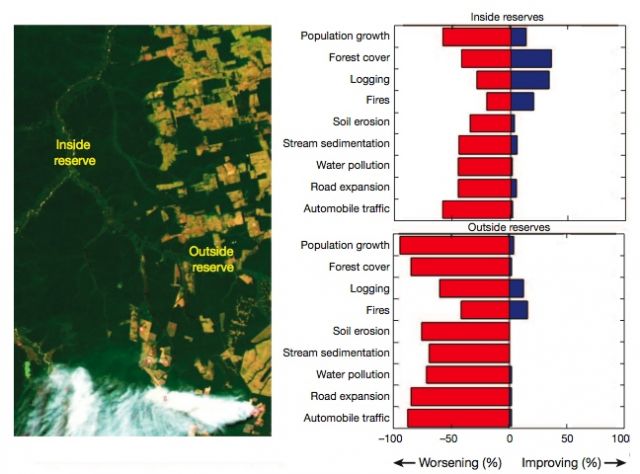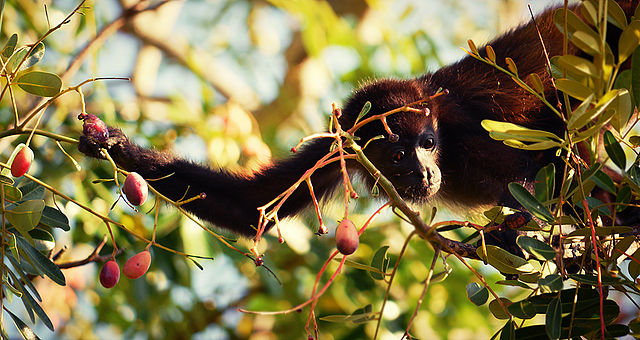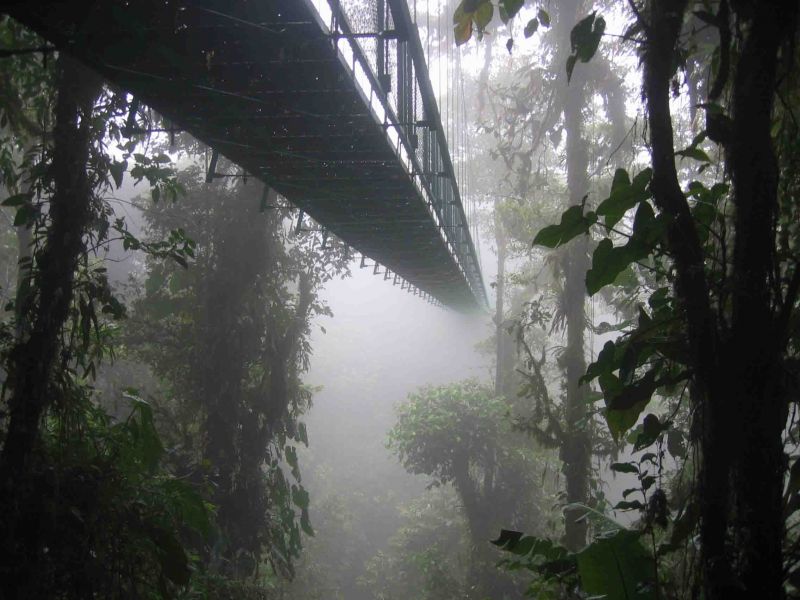 Tropical forest, Malaysia: Peter Coxhead via Wikimedia Commons
Tropical forest, Malaysia: Peter Coxhead via Wikimedia Commons
I was interested to read a new paper in the science journal Nature this week. Not least because it was co-authored by more than 200 scientists from around the world—a veritable who’s-who of researchers from the world of tropical forest ecology.
The gist of the paper is alarming:
- The rapid disruption of tropical forests worldwide probably imperils global biodiversity more than any other force today.
- The best hope lies in protected areas.
- Yet many protected areas are not effectively protecting biodiversity.
The authors write:
Our analysis reveals great variation in reserve ‘health:’ about half of all reserves have been effective or performed passably, but the rest are experiencing an erosion of biodiversity that is often alarmingly widespread taxonomically and functionally.
 Comparison of ecological changes inside vs outside protected areas, for selected environmental drivers. The bars show percentage of reserves with improving vs worsening conditions: Laurance, et al, Nature 2012, DOI:10.1038/nature11318
Comparison of ecological changes inside vs outside protected areas, for selected environmental drivers. The bars show percentage of reserves with improving vs worsening conditions: Laurance, et al, Nature 2012, DOI:10.1038/nature11318
The authors studied more than 30 different categories of species—from trees and butterflies to primates and large predators—in protected areas across the tropics in the Americas, Africa, Asia, and the Pacific. They calculated how these groups have fared in recent decades and identified the drivers of environmental change.
Lead author William Laurance of James Cook University in Australia and the Smithsonian Tropical Research Institute in Panama told me:
One of the things our study demonstrated was a sort of “mirror effect”—that the changes inside vs. outside [the reserves] tend to be positively correlated.
In other words, the reserves are only as strong as the lands surrounding them. And their power to protect biodiversity—that is, a full, healthy spectrum of lifeforms from the smallest to the largest—is threatened by activities on their borders, particularly from the illegal encroachment of colonists, hunters, and loggers.
 The jaguar, an apex predator: US Fish and Wildlife Service via Wikimedia CommonsThe authors found that some guilds—that is, ecological groups of plants and animals—were more at risk than others. The most sensitive guilds included apex predators, large non-predatory vertebrates, bats, stream-dwelling amphibians, terrestrial amphibians, lizards and larger reptiles, non-venomous snakes, freshwater fish, large-seeded old-growth trees, epiphytes (plants that grow on other plants, like orchids), and ecological specialists.
The jaguar, an apex predator: US Fish and Wildlife Service via Wikimedia CommonsThe authors found that some guilds—that is, ecological groups of plants and animals—were more at risk than others. The most sensitive guilds included apex predators, large non-predatory vertebrates, bats, stream-dwelling amphibians, terrestrial amphibians, lizards and larger reptiles, non-venomous snakes, freshwater fish, large-seeded old-growth trees, epiphytes (plants that grow on other plants, like orchids), and ecological specialists.
Several other groups were somewhat less vulnerable, including primates, understory insectivorous birds, large frugivorous [fruit-eating] birds, raptorial birds [birds of prey], venomous snakes, species that require tree cavities, and migratory species. In addition, five groups increased markedly in abundance in the reserves, including pioneer and generalist trees, lianas and vines, invasive animals, invasive plants and human diseases.
Considering that the most endangered species are living in protected areas that are themselves embedded in extremely degraded landscapes, then the picture looks even gloomier.
 Juvenile howler monkey picking berries: Alphamouse via Wikimedia Commons
Juvenile howler monkey picking berries: Alphamouse via Wikimedia Commons
But in my article in the May/June 2012 issue of Mother Jones, Can One Incredibly Stubborn Person Save an Ecosystem?, I wrote about the need to spend more time discussing and dissecting success stories in conservation biology. As things stand, the bad news stories overwhelm us and threaten to defeat our willpower and continued efforts.
So I asked Laurance, if we were to turn his paper around for a moment, what can we say is working in the 50 percent of reserves that are doing a decent job protecting biodiversity? His answer:
In very general terms, the 50 percent of reserves that were doing relatively well had (1) better on-the-ground protection inside the reserve, and (2) had suffered less-intense changes outside the reserve.
Thus the paper presents a blueprint of what to do, as well as what not to do, if we want to maintain Earth’s biodiversity in a rapidly changing world. The authors conclude:
Protected areas are a cornerstone of efforts to conserve tropical biodiversity. It is not our intent to diminish their crucial role but to highlight growing challenges that could threaten their success. The vital ecological functions of wildlife habitats surrounding protected areas create an imperative, wherever possible, to establish sizeable buffer zones around reserves, maintain substantial reserve connectivity to other forest areas and promote lower-impact land uses near reserves by engaging and benefiting local communities. A focus on managing both external and internal threats should also increase the resilience of biodiversity in reserves to potentially serious climatic change in the future.
The paper:
- William F. Laurance, et al. Averting biodiversity collapse in tropical forest protected areas. Nature (2012). DOI:10.1038/nature11318








